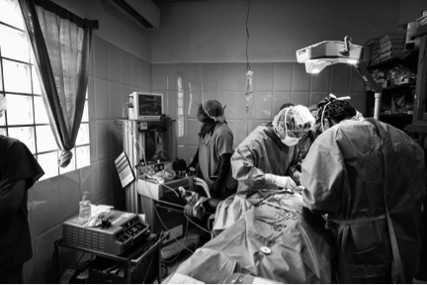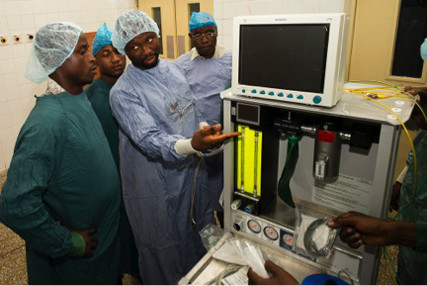 The Universal Anaesthesia Machine used for a procedure at Haitian Christian Mission Hospital in Haiti. (Photo by Steve Rudy)
The Universal Anaesthesia Machine used for a procedure at Haitian Christian Mission Hospital in Haiti. (Photo by Steve Rudy)
A recent evaluation of the Rockefeller Foundation’s Program-Related Investment Fund concluded that it has “generated modest financial returns for the Foundation, contributed to investees’ financial sustainability and generated positive social returns on a variety of fronts,” and that “the Rockefeller Foundation has contributed to the rapid evolution of the PRI field for the last two decades.”
Program-related investments (PRIs) can be powerful social investment tools. They also take many forms, including purchases of passive debt and active equity. The health care social enterprise I work for, Gradian Health Systems, benefits from a very promising active equity investment: It’s wholly owned by a family foundation.
We call this model “foundation-owned social enterprise,” or FOSE. In legal parlance, Gradian is known as both a “single member limited liability corporation” (SMLLC) and as a “disregarded entity” of the family foundation; functionally, this means that the foundation alone owns the company, and that Gradian’s financial statements roll up to the foundation’s 990 for tax reporting.
While SMLLCs are common in the business world, to our knowledge, they are little used in the social sector. Under the right conditions, however, the FOSE model can be an attractive option for both investors and investees, provided the investor is more committed to achieving a social, not just financial, return on investment.
Are you enjoying this article? Read more like this, plus SSIR's full archive of content, when you subscribe.
Of course, the term “social enterprise” covers a broad array of organizations—both for-profit and nonprofit—that use commercial strategies in the service of promoting a social goal. Some, like Warby Parker, produce high financial returns and look financially identical to typical enterprises; others expect lower financial returns and receive investment support from organizations like Acumen Fund; still others generate small or no returns and are generally incorporated as nonprofit organizations. Entrepreneurs are experimenting with each of these models, creating hybrid social enterprise models that fit the needs of their consumers and markets.
How FOSE Works
At Gradian, we sell the Universal Anaesthesia Machine (UAM), a medical device designed specifically to address the difficult operating theater environments found in many low-resources hospitals throughout the world. In contrast to traditional anaesthesia machines, the UAM can function without consistent electricity or a source of compressed oxygen—two major concerns for low-resource hospitals. It is also simple enough that hospital technicians can perform maintenance and repair.
Rather than donating the UAM to hospitals that need them, we sell the device at our cost, allowing us to keep the price as low as possible, scale production to meet market demands, and conserve philanthropic funding for overhead and the most broken aspect of the low-income medical device market: robust after-sales training, maintenance, service, and support.
This structure has worked well for us and our parent organization, the Nick Simons Foundation, and we think it holds promise for a wide variety of social enterprises and foundations. Most obviously, the investment reduces (or eliminates altogether) the need to spend time and resources on fundraising and financial reporting, which allows the social enterprise to focus on operations. A startup social enterprise can also cheaply piggyback on the foundation’s existing hard infrastructure (such as office space and technology) and soft infrastructure (such as tacit knowledge and mentors).
 The Universal Anaesthesia Machine in Connaught Hospital, Freetown, Sierra Leone. (Photo by Steve Rudy)
The Universal Anaesthesia Machine in Connaught Hospital, Freetown, Sierra Leone. (Photo by Steve Rudy)
Owning a social enterprise (or creating a disregarded entity) allows a foundation to efficiently effect change using market mechanisms to sell a good or service, while using philanthropic resources to address market failures and advocate a cause. Critically, it is also a tax-free investment vehicle for the foundation, fulfills the foundation’s requirement to spend 5 percent of its endowment annually, and because SMLLCs are autonomous legal entities, protects the foundation’s assets from any liability to which their investees expose them. We think this model could provide a more efficient option that conventional grant- and donation-based models.
The FOSE model isn’t appropriate for all social enterprises or all foundations. If it’s likely that a social enterprise will be profitable, a foundation’s funds are probably better invested in higher-risk, lower-return ventures, as the social enterprise can probably raise capital in more traditional debt and equity markets.
But FOSE has a great deal of potential to fill the gap that exists between typical social enterprises and traditional grant-based nonprofits. Social enterprises that use markets but don’t expect market returns on investment are great candidates for the model, as are foundations looking for new ways to efficiently meet their social impact goals.
As foundations experiment with the FOSE model they will likely iterate and improve on it, honing it into an even more powerful tool for social change. For that to happen, though, more individuals, foundations, and social enterprises need to learn about it, scrutinize it, and ultimately take the leap and give it a try. Let us know if you or other organizations you know are operating as a SMLLC owned by a 501(c)(3)!
Support SSIR’s coverage of cross-sector solutions to global challenges.
Help us further the reach of innovative ideas. Donate today.
Read more stories by Mike Miesen.

